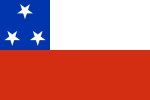| Liberating Expedition of Peru | |
|---|---|
 | |
| Active | 1820–1822 |
| Allegiance | |
| Type | Military forces |
| Role | Battle |
| Engagements | Spanish American wars of independence |
| Battle honours | Liberation of Lima and the coastal area of Peru. Proclamation the independence of Peru |
| Commanders | |
| Army Commander | José de San Martín |
| Fleet Commander | Thomas Cochrane |
| Insignia | |
| Identification symbol |  |
The Liberating Expedition of Peru (Spanish: Expedición Libertadora del Perú) was a naval and land military force created in 1820 by the government of Chile in continuation of the plan of the Argentine General José de San Martín to achieve the independence of Peru, and thus consolidate the independence of all former Spanish-American colonies. It was vital to defeat the Viceroyalty of Peru—the center of royalist power in South America—from where royalist expeditions were sent to reconquer the territories lost to the independence fighters.
Following the independence of Chile, achieved at the Battle of Maipú, General San Martín determined to achieve the independence of Peru. Accordingly, on February 5, 1819, a treaty was signed between the new Republic of Chile and the United Provinces of the Río de la Plata. The treaty was to create an amphibious, naval, and land military expeditionary force promoted by the government of Chile, with the mission of making Peru independent of the Spanish Empire and consolidating both the sovereignty of the new Republic of Chile and that of the United Provinces of the Río de la Plata, which became Argentina.
The parties to the treaty faced ongoing problems which hampered the launch of their liberating campaign. Chile was under imminent threat of further Spanish invasions, while the United Provinces of the Río de la Plata were in turmoil over internal disputes.[1] It was finally negotiated that the bulk of the effort and initial cost would essentially fall on the Government of Chile, and then the costs expended were to be borne by the future independent government of Peru. Bernardo O'Higgins, as Supreme Director of Chile, appointed José de San Martín chief of the United Liberation Army of Chile and the former British Naval officer, the Scot, Thomas, Lord Cochrane, commander of the naval fleet. In this way, the Liberating Army of Peru, thus named by supreme decree of the Congress of Chile, on May 19, 1820, was a combined force of units of the restored Chilean Army along with those elements belonging to the Liberating Army of the Andes, that had fought in the Peruvian War of Independence.[2][3]
The rebellion of Rafael del Riego of 1820 in Spain, made the threat of Spanish invasion of the Río de la Plata recede. The vice-admiral, Lord Cochrane, would succeed in sweeping away the remnants of Spanish naval power in the Pacific Ocean. These events allowed the land forces of General San Martín to embark in Valparaíso, disembark at Paracas Bay on September 8, occupy the city of Lima, and proclaim the independence of Peru on July 28, 1821.
The expedition liberated parts of Peru from Spanish Crown control. It would participate in the expeditions of Juan Antonio Álvarez de Arenales in the highlands of Peru and the campaigns of intermediate ports, and would remain in Peru until its dissolution with the mutiny of 1824 at the second siege of Callao.
The expedition was not successful in conquering the whole of Peru, and suffered several defeats against the Royalists in the highlands. The end of the war would only come with the military intervention of Gran Colombia. Following the self exile of San Martin in September 1822, and the military defeats under president José de la Riva Agüero, the congress decided to send a plea in 1823 for the help of Simón Bolívar.
One Squadron of Mounted Grenadiers Regiment, the sole remnants of the expeditionary force, were added to the units of the Army of Peru and the United Liberation Army of Peru, under the command of Simón Bolívar, which would complete the liberation of Peru in 1824-26.
- ^ a b Cite error: The named reference
colliersaterwas invoked but never defined (see the help page). - ^ Contreras y Cueto (2016). Historia del Perú republicano: Tomo 1. Lima-Perú: IEP. p. 22.
- ^ Ugarte, Renato Valenzuela (1999). Bernardo O'Higgins: el estado de Chile y el poder naval : en la independencia de los países del sur de América (in Spanish). Andres Bello. ISBN 978-956-13-1604-1. Retrieved 12 February 2021.